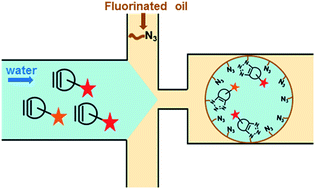Copper-free click chemistry for microdroplet's W/O interface engineering†
Abstract
In droplet-based microfluidic, fluorosurfactants are essential to ensure the stability of the emulsion. Beyond this primary role, fluorosurfactants can be engineered to provide droplet inner surface specific interaction characteristics with analyte present in droplet content. Despite the high potency of such capture system in terms of micro-compartmentalisation and surface/analyte ratio, only few studies have reported the use of the water/fluorinated oil interphase to immobilize target molecules. The difficult synthesis of the required functionalized fluorosurfactants needed for each application may account for this relative desertion. To make microdroplet capture approaches more straightforward, we have investigated a ready-to-use click chemistry-based approach that enables intra-droplet chemical modification. This strategy, which avoids tedious synthesis of complex fluorosurfactant, opens access to a wide variety of functional heads via copper-free click chemistry using a pre-functionalized fluorosurfactant which can be easily obtained in large scale. To demonstrate the efficiency of the click chemistry-based microdroplet surface functionalization, we have synthesized an azide fluorosurfactant capable of stabilizing microdroplets and performed a series of intra-droplet surface functionalizations by introducing fluorescent-labeled cycloalkyne derivatives in the aqueous phase. By doing so, we were able to demonstrate via polarization fluorescence that molecules from the aqueous phase could be efficiently captured at the inner droplet surface. Furthermore, we also showed that the density of azide functions at the inner surface could be adjusted by diluting the functionalized surfactant with a non-functionalized one. Fluorescence polarization analysis revealed that these dilutions result in the production of microdroplets with controlled azide surface density.

- This article is part of the themed collection: A Decade of Progress in Click Reactions Based on CuAAC

 Please wait while we load your content...
Please wait while we load your content...